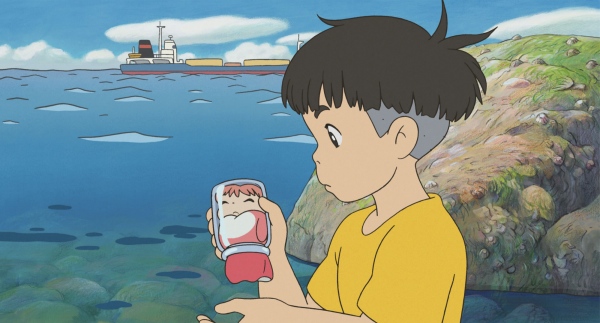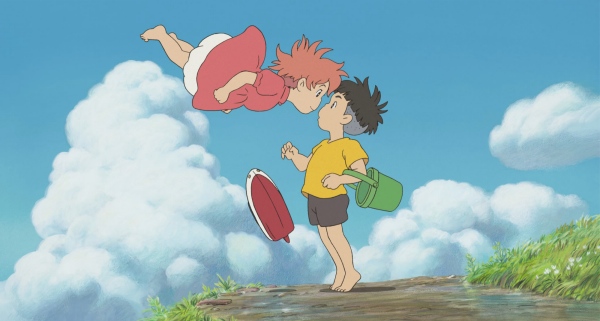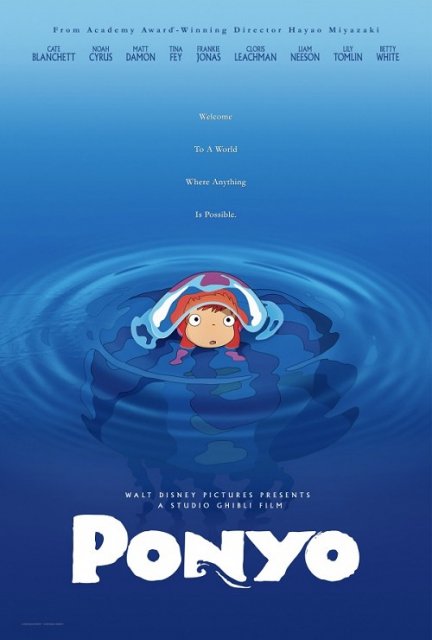Synopsis, More Stills, and Movie Review
SYNOPSIS
This is the story of Ponyo, a little fish from the sea who struggles to realize her dream of living with a boy named Sosuke. It also tells of how five-year old Sosuke manages to keep a most solemn promise.
Ponyo On The Cliff By The Sea places
Hans Christian Andersen’s The Little Mermaid in a contemporary Japanese setting. It is a tale of childhood love and adventure.
A little seaside town and a house at the top of a cliff. A small cast of characters. The ocean as a living presence. A world where magic and alchemy are accepted as part of the ordinary.
The sea below, like our subconscious mind, intersects with the wave-tossed surface above. By distorting normal space and contorting normal shapes, the sea is animated not as a backdrop to the story, but as one of its principal characters.
A little boy and a little girl, love and responsibility, the ocean and life - these things, and that which is most elemental to them, are depicted in the most basic way in ponyo on the cliff by the sea. This is my response to the afflictions and uncertainty of our times.
- Hayao Miyazaki
http://www.cinemaisdope.com/category/genre-fairy-tale/page/2/
Ponyo on the Cliff is the latest movie from director Hayao Miyazaki and Studio Ghibli, set to open on July 19 in Japan. It’s the story of a young goldfish who befriends a five-year-old boy during her quest to become a human herself. I for one cannot wait to see this, as Miyazaki films are among my most favorite movies, animated or not. He is a true artist, and I love anyone that helps keep the tradition of hand-drawn animation alive and at such a high level. And you’ve got to love his design for a goldfish. Awesome.
http://violintide-da.com/blog/?cat=10
News of the next film by Japanese Anime Master Hayao Mizayaki has been announced at the Ghibli World website. PONYO ON A CLIFF (Gake no ue no Ponyo) will tell the story of 5-year-old Sasuke, and Ponyo, a Princess Goldfish who wants only to become human. Miyazaki is creating the storyboards himself in watercolors and it is thought that the feature will be produced in the traditional hand-drawn 2-D manner.
http://www.chlotrudis.org/mewsings/2007_03_01_archive.html
It's kids' play for anime king
The Japan Times, Online
Friday, July 11, 2008
Director Hayao Miyazaki ('Spirited Away') delivers another classic
By Mark Schilling
Hayao Mizayaki is the reigning giant of Japanese animation — and the Japanese box office. Since "Majo no Takkyubin (Kiki's Delivery Service)" in 1989, every Miyazaki film has been a smash hit, drawing the widest possible audience. In 2001, his coming-of-age fantasy "Sen to Chihiro no Kamikakushi (Spirited Away)" set an all-time Japanese box-office record — ¥30.4 billion.
But this, and other Miyazaki megahits, including "Mononoke Hime (Princess Mononoke)" (1997) and "Howl no Ugoku Shiro (Howl's Moving Castle)" (2004) are anything but lowest-common-denominator entertainment. Even though his heroines (rarely heroes) are usually in their early teens or younger, their adventures unfold in rich visual and narrative matrices, with everything from personal memories and contemporary environmental concerns to ancient Japanese mythologies and fantastic European cityscapes tossed into the mix, in combinations that would only occur to Miyazaki's well-stocked, endlessly inventive mind. One reason his films keep the turnstiles spinning is that they repay — even require — repeated viewings.
But Miyazaki's most beloved film in Japan — "Tonari no Totoro (My Neighbor Totoro)" (1988) — is also among his easiest to understand. Even tots can thrill to the film's epic ride on the Cat Bus — one of the coolest forms of transportation ever invented, as long as you're not allergic to felines.
His latest feature animation, "Gake no Ue no Ponyo (Ponyo on the Cliff by the Sea)," exceeds even "Totoro" in simplicity, with a core target audience about as old as its hero — 5. This is not to say that those who have mastered hiragana (or the alphabet) will be bored, as long as they leave their expectations for the usual Miyazaki film at the door.
Miyazaki has made what is for any adult — but especially a 67-year-old
anime veteran — an extraordinary leap: In "Ponyo" he is not just telling a story to tikes, but imaginatively becoming one himself. I was reminded of the famous opening of James Joyce's "Portrait of the Artist as a Young Man," with its recital of the hero's earliest memories in the language of infancy ("Once upon a time there was a moocow coming down along the road and . . ."), as if the author were re-inhabiting an earlier self.
At the same time, Miyazaki revisits themes from other, more adult-focused films, such as humanity's destruction of the natural world, and nature's revenge on its human tormentors. Also, the animation is Miyazaki's familiar mix of the realistic and fantastic, with extinct sea creatures swimming contentedly alongside their contemporary — and accurately rendered — descendants. In other words, there is still plenty to engage the mind and eye, as well as keep the small army of Miyazaki explicators busy.
The title character, Ponyo (voice by Yuria Nara), is a girl fish with a human face who decides one day to leave her underwater home — and her school of smaller sisters — to see what lies on the surface. Riding on the back of a jellyfish, she is nearly trapped by a drift net, but escapes — with her head stuck in a glass jar. Sosuke (Hiroki Doi), a boy who lives on a house on a seaside cliff, spots Ponyo in the shallows and rescues her.
He is delighted with his new pet — and Ponyo is delighted to be in the human world at last. She says her first words, to Sosuke's astonishment — and begins a transformation from half-fish to human.
Meanwhile, her human father, Fujimoto (George Tokoro), who lives in an undersea manse with Ponyo's sea-queen mother (Yuki Amami), starts to search for her. With his long hair, beaky nose and tormented, bags-under-the-eyes expression, Fujimoto looks like a decayed aristocrat from a
shojo manga (girls' comic), but he possesses magical powers over the waves, which become like living creatures under his command. What can a mere kid, if one with a feisty mom he calls Lisa (Tomoko Yamaguchi), and a good-natured, if mostly absent, ship-captain dad (Kazushige Nagashima), do to stop him?
"Ponyo" is not about a simplistic struggle between good and evil, however. Fujimoto is more of a worried father than a scarily powerful villain. Also, with the aid of her sisters, Ponyo unleashes powers of her own, with awesome, if unintended, consequences.
The film meanders into various byways, such as the day-care center for the elderly that Lisa runs, with a female clientele that runs the gamut from the cute to the cranky — and serves as a Greek chorus to the action.
The focus, though, stays mostly on Sosuke and Ponyo, whose relationship undergoes a change from master/pet to protective older brother/bubbly, if trouble-prone, younger sister. There is something dreamlike about their adventures in both the thrilling wish-fulfillment of them and their spooky shape-shifting. Small children, who naturally live on the borderline between reality and fantasy, will have no trouble following along.
As with most Miyazaki films, I walked out of "Ponyo" thinking less about the rambling story, based loosely on "The Little Mermaid," than certain strangely gripping scenes, such as a grimly determined Lisa zipping along a seaside road in her mini car, with Sosuke at her side, as angry anthromorphic waves crash and lash around them, or Sosuke and Ponyo puttering idyllically over a submerged town in a toy boat powered by a burning candle, which has magically grown big enough to hold them.
No one but Miyazaki could have created anything like these moments, with anything like his mastery. If "Ponyo" is the start of his artistic second childhood, I say welcome to the sandbox.
http://search.japantimes.co.jp/cgi-bin/ff20080711a1.html










